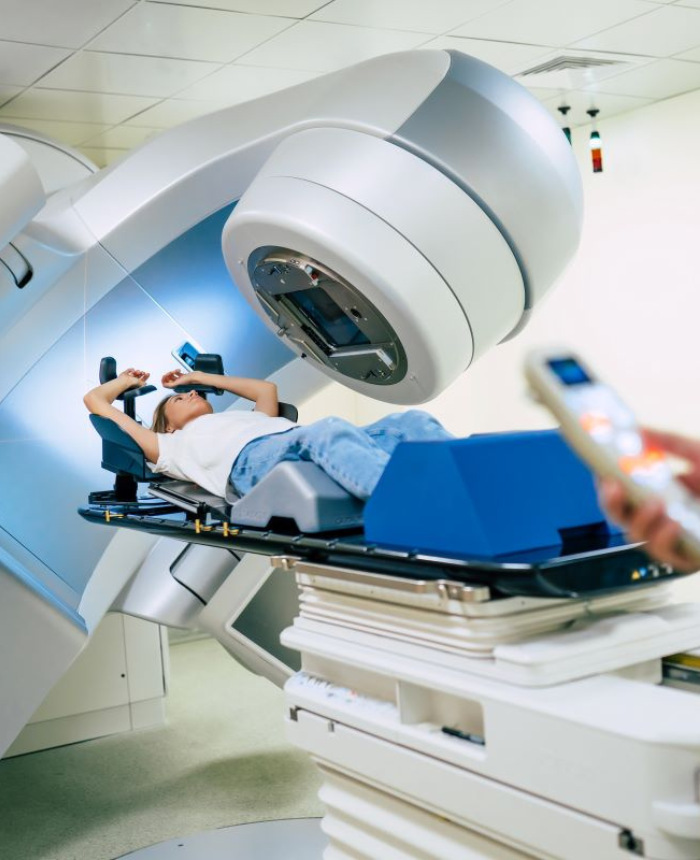
Radiation Treatments
Radiation therapy, or radiotherapy, is the precise use of high-energy rays to treat cancer. It is used to treat almost every type of cancer and even several non-cancerous conditions.
Radiation therapy is highly effective in destroying the cancer cell’s ability to reproduce, allowing the body to naturally rid itself of these dead or damaged cells.
Because it takes time for cancer cells to die or be damaged enough for the body to rid itself of them, radiotherapy treatment is typically five to eight weeks long. After radiation therapy treatment ends, the cancer cells keep dying for weeks or months.
Radiotherapy can be delivered before or after surgery as an effective way to reduce the risk of cancer recurrence, to treat cancer that has spread, or to ease symptoms caused by advanced cancer.
Our radiation oncologists work closely with medical and surgical oncology, urology, diagnostics, pathology, genetic risk evaluation, and supportive care to deliver unparalleled continuity of care.
Radiation therapy services
3-D conformational radiation therapy (3D-CRT)
Three-dimensional conformational radiation therapy (3D-CRT) uses computers, CT scans, and MRI scans to create detailed, three-dimensional representations of the tumor and the surrounding organs. The treatment team uses these images to shape the radiation beams to match the size and shape of the tumor. If you have this type of radiotherapy, you’ll notice that the team uses tools like multileaf collimators (customizable shields to protect surrounding tissue). Nearby normal tissue receives less radiation exposure because the radiation beams are targeted directly at the tumor.
Intensity-modulated radiotherapy (IMRT)
Intensity-modulated radiotherapy (IMRT) is an advanced form of external radiation treatment that allows precise targeting of tumor cells. The CT simulator localization scan or other 3-D images provide the radiation oncologist with an understanding of the shape and location of the tumor, increasing treatment accuracy while avoiding surrounding healthy tissue and organs.
Image-guided radiation therapy (IGRT)
Image-guided radiation therapy (IGRT) combines imaging techniques with the precise technology of either 3-D or intensity-modulated radiation therapy (IMRT) to ensure the radiation is pinpointed to the treatment area.
Stereotactic body radiotherapy (SBRT)
Stereotactic body radiotherapy (SBRT) is an advanced type of radiation therapy that delivers high doses of radiation using several beams of varying intensity aimed at a highly focused area of the body. Due to the high intensity of the radiation dose, a total of one to five treatments are given over a period of 1 to 10 days.
Radiopharmaceutical therapy services
Radiopharmaceutical therapy involves targeting cancer cells with a radioactive drug. These radiopharmaceutical medications typically consist of a radioactive atom combined with a molecule that seeks out cancer cells. The treatment brings radiation directly to the tumor cells, no matter where they are in the body. Radiopharmaceuticals can be injected into a vein or artery, taken orally as a liquid, or placed in a body cavity. The cancers treated by these therapies include metastatic prostate cancer, thyroid cancer, and well-differentiated neuroendocrine tumors. We use therapies that incorporate radium 223 and Pluvicto, also known as lutetium 177.
If you’re looking for state-of-the-art radiation therapy in a standalone clinic, close to home, call us to schedule an appointment. You can reach our Jeffersonville, IN, cancer center at 812.285.6000 or our Louisville, KY, cancer center at 502.409.9701.
Schedule Your Appointment Today
If you are referred for radiation therapy during your cancer care, you get to choose where to receive treatment. We are here to support and encourage you—call us today to schedule your first appointment with one of our radiation oncologists at the cancer center nearest to you.
